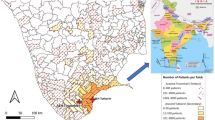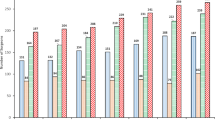Abstract
The aim of this study was to investigate the outcomes of sutureless, manual small-incision cataract surgery (SICS) in rural sub-Saharan Africa using standard intraocular lenses (IOLs). In order to assess the quality of surgery, we prospectively evaluated the visual outcomes of 1455 consecutive cataract operations performed in 2006 in patients ≥40 years at Nkhoma Eye Hospital, Malawi. All operations used standard 22-dioptre IOLs without pre-operative biometry. Outcomes were categorised according to the World Health Organization criteria, and causes of a poor outcome were recorded. Mean age of patients was 71.5 ± 9.5 years, and 53 % were female. Pre-operatively, 64 % of eyes had a visual acuity (VA) <6/60, and 41.3 % of eyes were blind (VA < 3/60). Without correction (uncorrected VA), nearly eighty percent (78.7 %) achieved a ‘good’ outcome (VA 6/6–6/18), 19.8 % were ‘borderline’ (VA < 6/18–6/60), and 1.5 % had a poor (VA < 6/60) outcome. With pinhole-correction, the proportion of good outcomes increased to 89.4 %, and poor outcomes decreased to 0.9 %. Poor outcomes were most commonly due to ocular co-morbidities (54.5 %) and refractive error (36.4 %). Older age and pre-operative blindness were strongly associated with borderline or poor visual outcomes. The most common surgical complication was posterior capsule tear (without vitreous loss). In a rural African environment, using standard IOL power plus SICS can lead to a high proportion of good outcomes and a low frequency of surgical complications. A comparative study is required to determine if any additional benefit in visual outcomes can be gained by the addition of biometry.
Similar content being viewed by others
References
Resnikoff S, Pascolini D, Etya’ale D, Kocur I, Pararajasegaram R, Pokharel GP, Mariotti SP (2004) Global data on visual impairment in the year 2002. Bull World Health Organ 82(11):844–851. doi:S0042-96862004001100009
Polack S, Kuper H, Mathenge W, Fletcher A, Foster A (2007) Cataract visual impairment and quality of life in a Kenyan population. Br J Ophthalmol 91(7):927–932. doi:10.1136/bjo.2006.110973
Lewallen S, Courtright P (2001) Blindness in Africa: present situation and future needs. Br J Ophthalmol 85(8):897–903
Wong TY (2005) Cataract surgery programmes in Africa. Br J Ophthalmol 89(10):1231–1232. doi:10.1136/bjo.2005.072645
World Health Organization (1997) The global initiative for elimination of avoidable blindness. Geneva
Gurung R, Hennig A (2008) Small incision cataract surgery: tips for avoiding surgical complications. Community Eye Health 21(65):4–5
World Health Organization (2007) Global initiative for the elimination of avoidable blindness: action plan 2006–2011. Geneva
Briesen S, Roberts H, Lewallen S (2010) The importance of biometry to cataract outcomes in a surgical unit in Africa. Ophthalmic Epidemiol 17(4):196–202. doi:10.3109/09286586.2010.498662
Yorston D, Foster A (1999) Audit of extracapsular cataract extraction and posterior chamber lens implantation as a routine treatment for age related cataract in east Africa. Br J Ophthalmol 83(8):897–901
Sherwin JC, Dean WH, Metcalfe NH (2008) Causes of blindness at Nkhoma Eye Hospital, Malawi. Eur J Ophthalmol 18(6):1002–1006
World Health Organization (2012) Change the definition of blindness. http://www.who.int/blindness/Change%20the%20Definition%20of%20Blindness.pdf. Accessed 15 Feb 2012
World Health Organization (1998) An informal consultation on analysis of blindness prevention outcome. WHO, Geneva, pp 16–18
Yorston D, Gichuhi S, Wood M, Foster A (2002) Does prospective monitoring improve cataract surgery outcomes in Africa? Br J Ophthalmol 86(5):543–547
Courtright P, Metcalfe N, Hoechsmann A, Chirambo M, Lewallen S, Barrows J, Witte C (2004) Cataract surgical coverage and outcome of cataract surgery in a rural district in Malawi. Can J Ophthalmol 39(1):25–30
Imam AU, Gilbert CE, Sivasubramaniam S, Murthy GV, Maini R, Rabiu MM (2010) Outcome of cataract surgery in Nigeria: visual acuity, autorefraction, and optimal intraocular lens powers—results from the Nigeria national survey. Ophthalmology. doi:10.1016/j.ophtha.2010.08.025
Mathenge W, Kuper H, Limburg H, Polack S, Onyango O, Nyaga G, Foster A (2007) Rapid assessment of avoidable blindness in Nakuru district, Kenya. Ophthalmology 114(3):599–605. doi:10.1016/j.ophtha.2006.06.057
Kalua K, Lindfield R, Mtupanyama M, Mtumodzi D, Msiska V (2011) Findings from a rapid assessment of avoidable blindness (RAAB) in Southern Malawi. PLoS ONE 6(4):e19226. doi:10.1371/journal.pone.0019226
Yorston D (2005) High-volume surgery in developing countries. Eye (Lond) 19(10):1083–1089. doi:10.1038/sj.eye.6701966
Dean WH, Banda L, Kambewa ES, Sherwin JC (2012) Increased intraocular pressure on the first post-operative day following sutureless extracapsular cataract surgery in Africa. Eye (Lond) 26(2):332. doi:10.1038/eye.2011.273
Dean WH, Patel D, Sherwin JC, Metcalfe NH (2011) Follow-up survey of cataract surgical coverage and barriers to cataract surgery at Nkhoma, Malawi. Ophthalmic Epidemiol 18(4):171–178. doi:10.3109/09286586.2011.590918
Cook C (2000) How to improve the outcome of cataract surgery. Community Eye Health 13(35):37–38
Lindfield R, Kuper H, Polack S, Eusebio C, Mathenge W, Wadud Z, Rashid AM, Foster A (2009) Outcome of cataract surgery at one year in Kenya, the Philippines and Bangladesh. Br J Ophthalmol 93(7):875–880. doi:10.1136/bjo.2008.152744
Dandona L, Dandona R, Naduvilath TJ, McCarty CA, Mandal P, Srinivas M, Nanda A, Rao GN (1999) Population-based assessment of the outcome of cataract surgery in an urban population in southern India. Am J Ophthalmol 127(6):650–658
Chibuga E, Massae P, Geneau R, Mahande M, Lewallen S, Courtright P (2008) Acceptance of cataract surgery in a cohort of Tanzanians with operable cataract. Eye (Lond) 22(6):830–833. doi:10.1038/sj.eye.6702736
Schwarzmann M (2008) Postoperative refraction study for sutureless cataract surgery with standard 22 dioptre IOL, Diploma thesis, Aalen University, Germany
Briesen S, Roberts H, Karimurio J, Kollmann M (2010) Biometry in cataract camps. Experiences from north Kenya. Ophthalmologe 107(4):354–358. doi:10.1007/s00347-009-2021-2
Daniel C, Tuft S, Ionides A, Bunce C (2003) Effect of visual acuity on biometry prediction error after cataract surgery. J Cataract Refract Surg 29(7):1365–1369
Connell B, Brian G, Bond MJ (1997) A case-control study of biometry in healthy and cataractous Eritrean eyes. Ophthalmic Epidemiol 4(3):151–155
Sherwin JC, Lewallen S, Courtright P (2012) Blindness and visual impairment due to uncorrected refractive error in sub-Saharan Africa: review of recent population-based studies. Br J Ophthalmol. doi:10.1136/bjophthalmol-2011-300426
Beatty J, Cook C, Murdoch I (2004) Refractive error following cataract extraction with the implantation of a standard power intraocular lens in a rural African blindness prevention programme. Eye (Lond) 18(2):194–195. doi:10.1038/sj.eye.67005496700549
Tilahun Y, Sisay A (2006) Audit of exracapsular cataract extraction with posterior chamber intraocular lens implantation in a tertiary eye care center in Ethiopia. Ethiop Med J 44(1):61–66
Limburg H, Foster A, Gilbert C, Johnson GJ, Kyndt M, Myatt M (2005) Routine monitoring of visual outcome of cataract surgery. Part 2: results from eight study centres. Br J Ophthalmol 89(1):50–52. doi:10.1136/bjo.2004.045369
Acknowledgments
We would like to thank the staff of Nkhoma Eye Hospital, and Markus Schwarzmann for his previous work at Nkhoma. WHD and NHM are supported by CBM.
Conflicts of interest
No authors of this paper have any conflicts of interest related to this research.
Author information
Authors and Affiliations
Corresponding author
Rights and permissions
About this article
Cite this article
Sherwin, J.C., Dean, W.H., Schaefers, I. et al. Outcomes of manual small-incision cataract surgery using standard 22 dioptre intraocular lenses at Nkhoma Eye Hospital, Malawi. Int Ophthalmol 32, 341–347 (2012). https://doi.org/10.1007/s10792-012-9565-x
Received:
Accepted:
Published:
Issue Date:
DOI: https://doi.org/10.1007/s10792-012-9565-x




